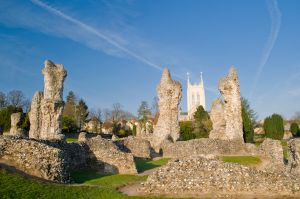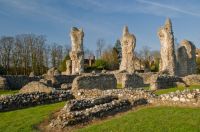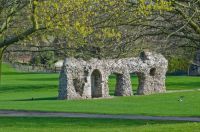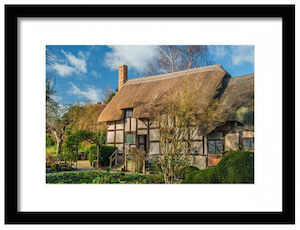
In AD 663 King Sigebert of the East Angles established a religious community of secular priests in Bury. In 903 the body of St Edmund was buried here, over 30 years after his unpleasant death at the hands of the Danes. In 1020 King Canute re-established the settlement as a Benedictine monastery, with 20 monks.
William the Conqueror expanded the number of monks by 60 and granted the abbey additional privileges. In 1095 St Edmund's remains were reburied in a new stone church.
Shortly after that, the abbey was greatly expanded with the building of a refectory, chapter house, cloisters, infirmary, and dormitory. The abbey was damaged by fire in 1150, and almost all of the buildings had to be rebuilt. The church was expanded later in the 12th century.
Relations between the abbey and the townsfolk of Bury were turbulent at best, and the friction erupted into riots in 1327. In 1465 the church and refectory were damaged by a fire and rebuilt.
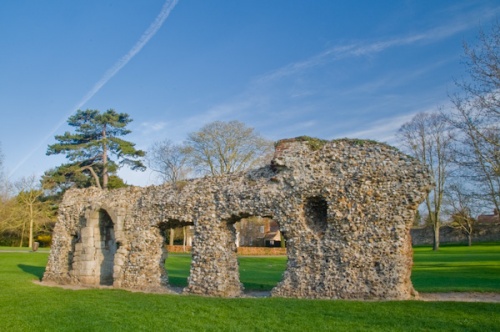
During the Middle Ages, Bury St Edmunds was the most powerful and richest Benedictine Abbey in England, but that power did not last. Henry VIII dissolved the abbey in 1540 and sold the property.
Much of the stone was carried away to be used in other building projects, although the abbot's palace survived as a private house until 1720. Further private houses were built onto the west front of the abbey church.
The abbey church was a huge building, measuring over 500 feet in length, with a nave of 12 bays. The oldest surviving part of the church is the apsidal crypt, which was built by Abbot Baldwin around 1066.

The abbey today consists of remains of the church, cloister, parlour, refectory, chapter house, night stair, warming house, abbot's chapel, Queen's Chamber, and treasury. The abbey battlemented Great Gate still stands also. This was built following the riots of 1327 and finished after 1353. It is two stories high and beautifully decorated.
The abbey site is open at any time.
About Bury St Edmunds Abbey
Address: Angel Hill,
Bury St Edmunds,
Suffolk,
England, IP33 1LS
Attraction Type: Abbey
Location: At the east of the town centre. Open access site.
Website: Bury St Edmunds Abbey
English Heritage - see also: English Heritage memberships (official website)
Location
map
OS: TL859642
Photo Credit: David Ross and Britain Express
Opening Details: Open access site, usually accessible at any reasonable time
HERITAGE
 We've 'tagged' this attraction information to help you find related historic attractions and learn more about major time periods mentioned.
We've 'tagged' this attraction information to help you find related historic attractions and learn more about major time periods mentioned.
Find other attractions tagged with:
12th century (Time Period) - Canute (Person) - chapter house (Architecture) - Decorated (Architecture) - Henry VIII (Person) - William the Conqueror (Person) -
NEARBY HISTORIC ATTRACTIONS
Heritage Rated from 1- 5 (low to exceptional) on historic interest
St Edmundsbury Cathedral - 0.3 miles (Historic Church) ![]()
Bury St Edmunds St Mary's Church - 0.3 miles (Historic Church) ![]()
Greene King Brewery Museum - 0.4 miles (Museum) ![]()
Theatre Royal, Bury St Edmunds - 0.4 miles (Historic Building) ![]()
Moyses Hall Museum - 0.4 miles (Museum) ![]()
Suffolk Regiment Museum - 1.1 miles (Museum) ![]()
Ickworth - 3.4 miles (Historic House) ![]()
West Stow, St Mary's Church - 4.6 miles (Historic Church) ![]()
Nearest Holiday Cottages to Bury St Edmunds Abbey:
Windsor Green, Suffolk
Sleeps: 8
Stay from: £1183 - 3941
More self catering near Bury St Edmunds Abbey



